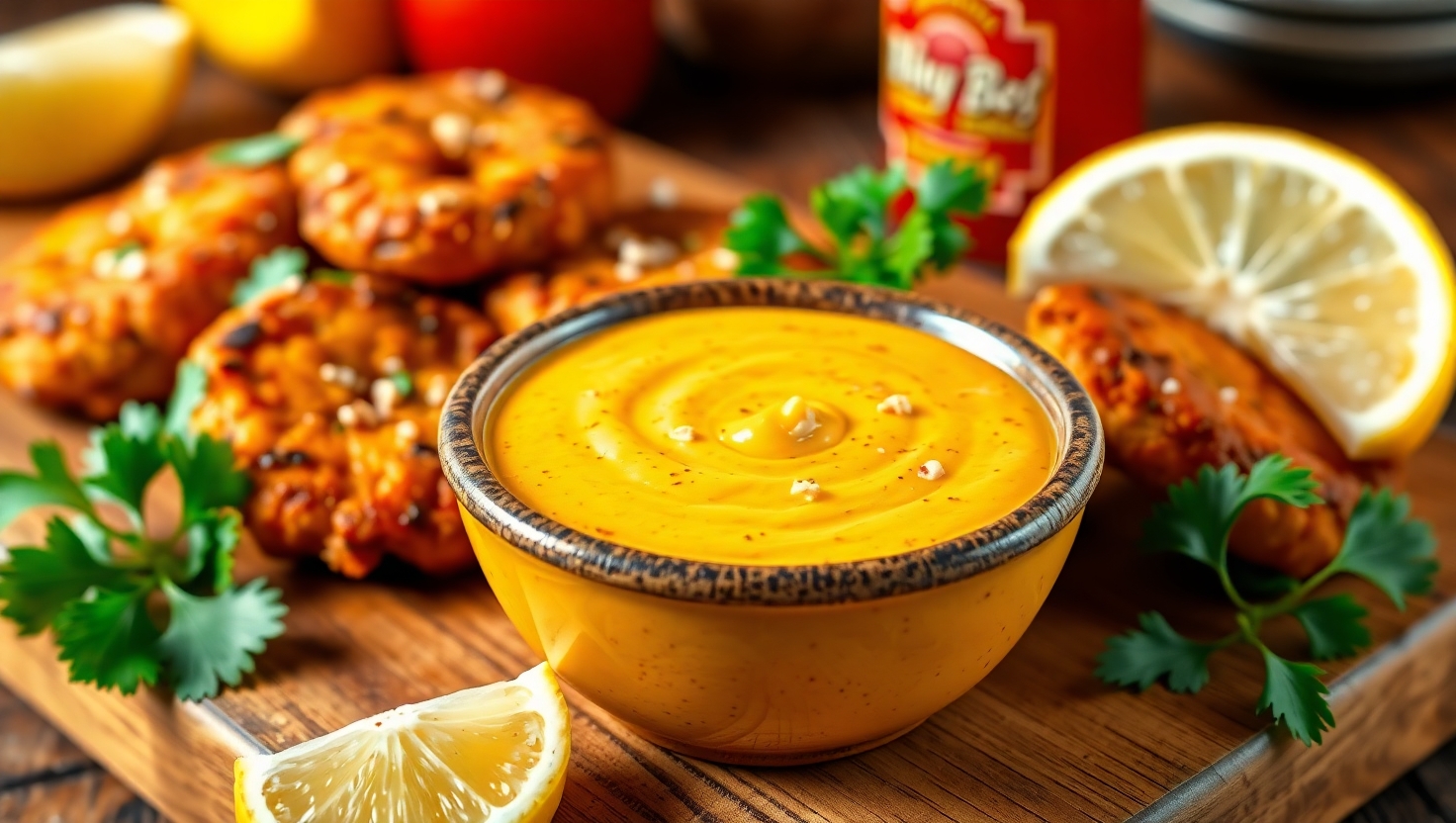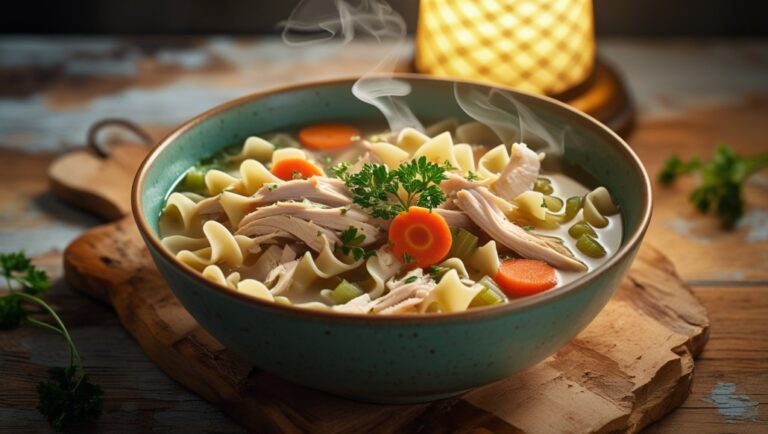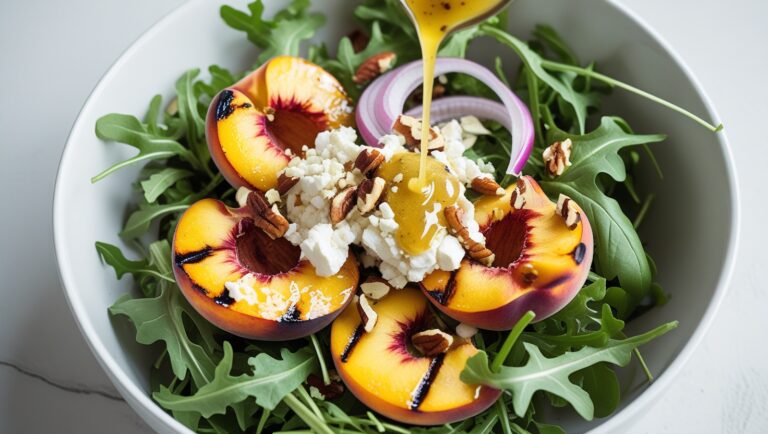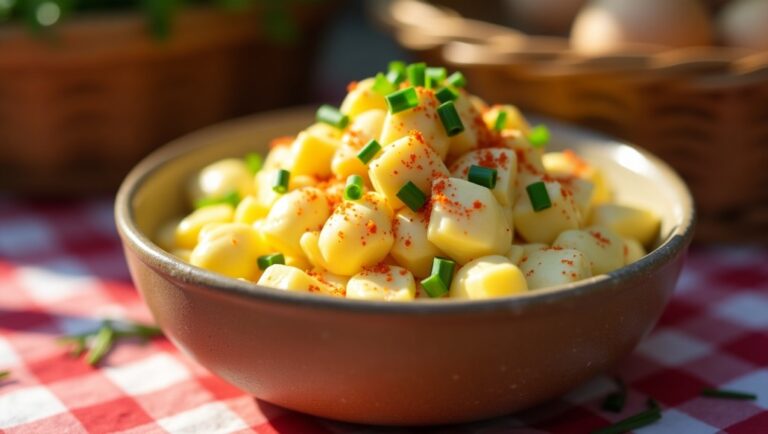Louisiana Remoulade Sauce: A Cajun Classic
The Cajun classic known as Louisiana Remoulade Sauce has been a staple in Louisiana cuisine for generations. This spicy remoulade sauce is not just a condiment; it’s a flavor enhancer that elevates dishes from ordinary to extraordinary.

With its rich history rooted in Louisiana’s cultural heritage, this classic louisiana condiment has become a beloved accompaniment to various foods. Whether you’re looking to add a tangy twist to your seafood or a burst of flavor to your sandwiches, an authentic remoulade recipe is a must-have in your culinary arsenal.
Key Takeaways
- Discover the rich history behind Louisiana Remoulade Sauce.
- Learn how to make an authentic remoulade recipe.
- Explore the versatility of this Cajun classic in various dishes.
- Understand the significance of remoulade sauce in Louisiana cuisine.
- Get tips on incorporating spicy remoulade sauce into your meals.
The Rich History of Remoulade Sauce
With roots in European cuisine, remoulade sauce has become an integral part of Louisiana’s culinary identity. This traditional Cajun condiment has a rich history that spans centuries, evolving from its French origins to become a staple in Louisiana cuisine.
French Origins and Evolution
The story of remoulade sauce begins in France, where it was originally made with mayonnaise, mustard, and herbs. The sauce was a staple in French cuisine, particularly in the port city of Le Havre, where it was served with seafood.
Journey to Louisiana
As French colonizers traveled to Louisiana, they brought their culinary traditions with them, including remoulade sauce. The sauce adapted to the local cuisine, incorporating new ingredients and flavors.
From European Classic to Cajun Staple
Over time, remoulade sauce became a Cajun staple, particularly in the context of Louisiana’s seafood-rich cuisine. The sauce evolved to include local ingredients, such as hot peppers and herbs, giving it a unique flavor profile that is distinct from its French counterpart.
Today, Louisiana remoulade sauce is celebrated as a key component of the state’s culinary heritage, reflecting the cultural exchange and adaptation that has shaped the region’s cuisine.
What Makes Louisiana Remoulade Sauce Unique
While Remoulade Sauce originated in France, its Louisiana counterpart has developed a unique identity. This divergence is largely due to the cultural melting pot that characterizes Louisiana’s culinary landscape.

Comparing French vs. Louisiana Styles
The traditional French Remoulade is mayonnaise-based, often served as a condiment. In contrast, Louisiana Remoulade Sauce has evolved to incorporate local flavors and ingredients, making it tangier and more versatile.
Cajun and Creole Influences
Cajun and Creole cuisines have significantly influenced Louisiana Remoulade, introducing spices and ingredients that differentiate it from its French roots. The addition of hot sauce, herbs, and other local seasonings has transformed the sauce into a staple of Louisiana cuisine.
Regional Variations Within Louisiana
Regional variations of Remoulade Sauce exist within Louisiana, reflecting the diverse culinary traditions across the state. From the Creole cuisine of New Orleans to the Cajun flavors of Acadiana, each region adds its unique twist to the sauce.
The uniqueness of Louisiana Remoulade Sauce lies in its ability to adapt and evolve, incorporating various cultural influences while maintaining its core characteristics. This adaptability has cemented its place in traditional Louisiana cuisine.
Essential Ingredients for Authentic Louisiana Remoulade Sauce
The foundation of a true Louisiana Remoulade Sauce is built upon a careful selection of key ingredients. These components work together to create the distinctive flavor profile that characterizes this Cajun classic.
The Base: Mayonnaise vs. Oil
The base of Louisiana Remoulade Sauce is typically mayonnaise, which provides a rich and creamy texture. Some recipes may use oil as a thinner alternative, but mayonnaise remains the traditional choice.
Traditional Cajun Seasonings
Cajun seasonings are a crucial element, adding depth and warmth to the sauce. These seasonings often include a blend of spices such as paprika, garlic powder, and onion powder.
Secret Ingredients That Make the Difference
Beyond the base and traditional seasonings, there are several secret ingredients that elevate Louisiana Remoulade Sauce to its authentic state.
Creole Mustard
Creole mustard is a key component, offering a tangy flavor that complements the richness of the mayonnaise. Its slightly spicy kick is a hallmark of authentic Louisiana Remoulade.
Louisiana Hot Sauce
Louisiana Hot Sauce adds a layer of heat, adjustable to taste. This ingredient is crucial for those who prefer a spicier remoulade.
Fresh Herbs and Aromatics
Fresh herbs such as parsley, dill, and chives, along with aromatics like garlic and onion, are finely chopped and added to the mix, enhancing the sauce’s freshness and complexity.

| Ingredient | Role in Remoulade | Example |
|---|---|---|
| Mayonnaise | Base | Duke’s Mayonnaise |
| Creole Mustard | Flavor Enhancer | Zatarain’s Creole Mustard |
| Louisiana Hot Sauce | Heat | Tony Chachere’s Hot Sauce |
| Fresh Herbs | Freshness | Parsley, Dill, Chives |
By combining these essential ingredients, one can create an authentic Louisiana Remoulade Sauce that is both flavorful and true to its Cajun heritage.
Step-by-Step Louisiana Remoulade Sauce Recipe
Creating Louisiana Remoulade Sauce from scratch is a straightforward process that requires just a few ingredients and some simple techniques. This homemade version captures the essence of the traditional Cajun condiment, perfect for enhancing seafood, sandwiches, and more.
Gathering Your Ingredients
To start, you’ll need to gather the essential ingredients for your Louisiana Remoulade Sauce. These include mayonnaise, ketchup, hot sauce (such as Tabasco), chopped herbs (like parsley and chives), garlic, and various Cajun seasonings. Ensure that you’re using fresh, high-quality ingredients to achieve the best flavor.

Mixing Techniques for Perfect Texture
The key to a great Remoulade Sauce lies in its smooth, creamy texture. Begin by mixing your mayonnaise and ketchup in a bowl until well combined. Then, add your chopped herbs, garlic, and Cajun seasonings. Mix thoroughly until the sauce is smooth and there are no visible lumps. For an extra creamy texture, you can add a bit more mayonnaise or a splash of lemon juice.
Resting and Developing Flavors
Once your sauce is mixed, it’s crucial to let it rest. Cover the bowl with plastic wrap and refrigerate the sauce for at least 30 minutes to allow the flavors to meld together. This resting period enhances the overall taste, making the sauce more complex and delicious.
Adjusting Spice Levels to Taste
After the sauce has rested, give it a taste and adjust the spice levels as needed. If it’s not spicy enough, add a bit more hot sauce. If it needs more zing, a squeeze of fresh lemon juice can do the trick. This step ensures that your Louisiana Remoulade Sauce is tailored to your taste preferences.
By following these simple steps, you can create a delicious and authentic Louisiana Remoulade Sauce at home. Enjoy it with your favorite dishes, from seafood to sandwiches, and experience the rich flavors of Cajun cuisine.
Popular Variations of Louisiana Remoulade Sauce
The versatility of Louisiana Remoulade Sauce is showcased through its numerous variations, each offering a unique twist on the classic recipe.
White Remoulade (Mayo-Based)
The traditional white remoulade is a mayonnaise-based version, characterized by its creamy texture and tangy flavor. This variation is often used as a dip for seafood or as a topping for po’ boy sandwiches.
Red Remoulade (Ketchup or Paprika-Based)
In contrast, the red remoulade gets its distinctive color and flavor from ingredients like ketchup or paprika. This variation adds a slightly sweeter and smokier dimension to the sauce, making it a favorite among those looking for a different taste profile.

Spicy Cajun Remoulade
For those who enjoy a bit of heat, the Spicy Cajun Remoulade is a thrilling option. This version incorporates additional spices and hot peppers, amplifying the sauce’s Cajun heritage and making it perfect for adventurous eaters.
Modern Interpretations and Fusion Styles
Modern chefs have been experimenting with innovative variations of Louisiana Remoulade Sauce, incorporating ingredients from other cuisines to create fusion styles. These contemporary versions range from adding Asian chili flakes to mixing in Mediterranean herbs, showcasing the sauce’s adaptability.
| Variation | Key Ingredients | Typical Use |
|---|---|---|
| White Remoulade | Mayonnaise, herbs, mustard | Seafood dip, po’ boy topping |
| Red Remoulade | Ketchup or paprika, mayonnaise | Grilled meats, vegetables |
| Spicy Cajun Remoulade | Hot peppers, Cajun spices | Spicy dishes, seafood |
| Modern Fusion | Varied international ingredients | Innovative dishes, fusion cuisine |
These variations demonstrate the dynamic nature of Louisiana Remoulade Sauce, allowing it to be enjoyed in multiple ways across different culinary contexts.
Perfect Pairings: What to Serve with Louisiana Remoulade Sauce
The rich flavor of Louisiana Remoulade Sauce makes it a perfect accompaniment to many Cajun and Creole classics. This versatile condiment has the ability to elevate a wide range of dishes, from traditional seafood to innovative fusion cuisine.
Classic Seafood Companions
Seafood is a staple in Louisiana cuisine, and Remoulade Sauce pairs exceptionally well with various seafood delicacies. The creamy texture and tangy flavor complement the freshness of the seafood, creating a delightful culinary experience.
Shrimp and Crawfish
Shrimp and crawfish are two of the most popular seafood choices in Louisiana, and they pair beautifully with Remoulade Sauce. Whether you’re enjoying boiled shrimp or a crawfish boil, a side of Remoulade Sauce adds a rich, creamy element to the dish. As Chef John Folse, a renowned Louisiana chef, once said, “Remoulade Sauce is the perfect accompaniment to seafood, enhancing its natural flavors.”
Fried Catfish and Oysters
Fried catfish and oysters are other seafood favorites that benefit from the addition of Remoulade Sauce. The sauce’s creamy texture provides a nice contrast to the crispy exterior of fried catfish, while its tangy flavor complements the brininess of oysters.

Iconic Po’ Boy Sandwiches
Po’ Boy sandwiches are a Louisiana tradition, and Remoulade Sauce is often a key ingredient. Whether you’re making a fried oyster Po’ Boy or a shrimp Po’ Boy, adding Remoulade Sauce brings the sandwich to life. It adds moisture, flavor, and a touch of Creole sophistication.
“A good Po’ Boy is all about the harmony of its ingredients, and Remoulade Sauce is the glue that holds it together.” –
Emeril Lagasse
Beyond Seafood: Other Delicious Applications
While Remoulade Sauce is famously paired with seafood, its uses extend far beyond. It can be used as a dip for vegetables, a sauce for grilled meats, or even as a topping for baked potatoes. The versatility of Remoulade Sauce makes it a valuable addition to any kitchen.
In conclusion, Louisiana Remoulade Sauce is a condiment with a wide range of applications, from classic seafood dishes to innovative uses in modern cuisine. Its rich flavor and creamy texture make it a perfect pairing for many foods, solidifying its place in the heart of Louisiana’s culinary traditions.
Louisiana Remoulade Sauce in Cajun Culture
Louisiana Remoulade Sauce is more than just a condiment; it’s a cultural icon in Cajun traditions. It plays a vital role in various aspects of Cajun life, from traditional celebrations to family recipes passed down through generations.
Role in Traditional Celebrations
In Cajun culture, Remoulade Sauce is a staple at traditional celebrations such as family gatherings and community festivals. It’s often served alongside seafood dishes, enhancing the flavors of the cuisine. During events like crawfish boils, Remoulade Sauce is used as a dipping sauce, bringing people together over delicious food.
Family Recipes and Heritage
Remoulade Sauce is deeply rooted in Cajun family heritage. Many families have their own secret recipes, passed down through generations. These recipes are often closely guarded and are a source of pride, reflecting the family’s history and cultural identity.
Restaurant Staples Across the South
Beyond family kitchens, Louisiana Remoulade Sauce has become a staple in restaurants across the South. It’s commonly used in Po’ Boy sandwiches and as a complement to seafood dishes. Restaurants pride themselves on their Remoulade recipes, often touting them as a signature item on their menus.

The significance of Remoulade Sauce in Cajun culture extends beyond its taste; it’s a symbol of community and tradition. Whether in family gatherings or served in restaurants, it continues to play a vital role in Louisiana’s culinary heritage.
Tips from Louisiana Chefs for Perfect Remoulade
Creating the perfect Remoulade Sauce is an art form, and Louisiana chefs are here to share their secrets. With years of experience in crafting this Cajun classic, they offer invaluable insights into making a Remoulade that complements any dish.
Ingredient Selection and Quality
Louisiana chefs emphasize the importance of using high-quality ingredients. “The freshness of your herbs and the quality of your mayonnaise can make or break your Remoulade,” says Chef Jacques, a renowned figure in New Orleans cuisine. When selecting ingredients, consider the following:
- Fresh parsley and chives for a vibrant flavor
- High-quality mayonnaise as the base
- Authentic Cajun seasonings for that signature taste
For a detailed breakdown of essential ingredients, refer to the comparison table below:
| Ingredient | Basic Remoulade | Gourmet Remoulade |
|---|---|---|
| Mayonnaise | Standard mayonnaise | Artisanal mayonnaise |
| Herbs | Dried parsley | Fresh parsley and chives |
| Seasonings | Basic Cajun seasoning | Custom blend of Cajun spices |
Balancing Flavors Like a Pro
Balancing the tangy, creamy, and spicy elements of Remoulade Sauce is crucial. “It’s all about harmony,” notes Chef Marie, a celebrated chef in Baton Rouge. “You want the flavors to complement each other without overpowering the dish it’s accompanying.”
To achieve this balance, start with a neutral base (mayonnaise), then add your seasonings and herbs gradually, tasting as you go. Adjust the spice level to your liking, and don’t hesitate to add a squeeze of fresh lemon juice to brighten the flavors.
“The key to a great Remoulade is in the balance. You want it to be tangy, creamy, and just spicy enough to leave a mark.” – Chef Jacques
Common Mistakes to Avoid
Even experienced cooks can fall into common traps when making Remoulade Sauce. One of the most frequent mistakes is using low-quality ingredients, which can result in a bland or unappetizing sauce. Another is not adjusting the seasoning properly, leading to an unbalanced flavor profile.
To avoid these pitfalls, always taste your Remoulade as you prepare it and be willing to make adjustments. Remember, the quality of your ingredients directly impacts the final product.

Make-Ahead and Storage Recommendations
Remoulade Sauce can be made ahead of time, which is convenient for meal planning and preparation. “Making it a day in advance allows the flavors to meld together beautifully,” advises Chef Jacques.
For storage, keep your Remoulade Sauce in an airtight container in the refrigerator. It typically lasts for up to a week when stored properly. Give it a good stir before serving, and adjust the seasoning if necessary.
By following these expert tips from Louisiana chefs, you can create a Remoulade Sauce that is sure to impress. Whether you’re serving it with seafood, using it as a dip, or incorporating it into your favorite dishes, the perfect Remoulade is within your reach.
Health Considerations and Dietary Adaptations
The rich flavor of Louisiana Remoulade Sauce comes with nutritional considerations that are important for consumers to understand. While it’s a delicious addition to many dishes, its traditional recipe is high in calories and fat due to the mayonnaise base.
Nutritional Profile of Traditional Remoulade
Traditional Louisiana Remoulade Sauce is made with mayonnaise, herbs, and spices. A typical serving size (about 2 tablespoons) contains approximately 190 calories, with 21g of fat, 1g of carbohydrates, and negligible protein.
| Nutrient | Amount per 2 tbsp serving |
|---|---|
| Calories | 190 |
| Fat | 21g |
| Carbohydrates | 1g |
| Protein | Negligible |
Lighter and Healthier Variations
To make a lighter version, consider substituting mayonnaise with Greek yogurt or avocado. This not only reduces the fat content but also adds a creamy texture and extra nutrients.
Healthier Alternatives: Use low-fat mayonnaise or a combination of yogurt and mayonnaise to reduce calorie intake.
Gluten-Free and Vegan Alternatives
For those with dietary restrictions, Remoulade Sauce can be adapted. Use vegan mayonnaise for a vegan version, and ensure that all added ingredients are gluten-free.

By making a few simple adjustments, Louisiana Remoulade Sauce can be enjoyed by a wider range of people, including those with gluten intolerance or vegan dietary preferences.
Conclusion: Celebrating the Versatility of Louisiana Remoulade Sauce
Louisiana Remoulade Sauce is a true Cajun classic, bringing a burst of flavor to various dishes. Its versatility is evident in its numerous uses, from seafood accompaniments to sandwich spreads.
This sauce is a staple in Louisiana cuisine, reflecting the region’s rich cultural heritage. By incorporating traditional Cajun seasonings and ingredients, Louisiana Remoulade Sauce creates a unique taste experience.
As explored in this article, the sauce can be adapted and modified to suit different tastes and dietary needs. Whether you’re looking to enhance your seafood dishes or add a tangy twist to your sandwiches, Louisiana Remoulade Sauce is an excellent choice.
With its rich history and diverse applications, Louisiana Remoulade Sauce is sure to remain a beloved condiment in Louisiana cuisine. Experiment with different variations and discover the many uses of this Cajun classic, celebrating its role in shaping the region’s culinary identity.
FAQ
What is Louisiana Remoulade Sauce?
Louisiana Remoulade Sauce is a quintessential Cajun condiment originating from Louisiana, known for its creamy texture and tangy flavor, often used to complement seafood and other dishes.
What are the main ingredients in Louisiana Remoulade Sauce?
The main ingredients include mayonnaise, Creole mustard, herbs like parsley and dill, garlic, and sometimes hot sauce, which give it a distinctive flavor.
How does Louisiana Remoulade differ from its French counterpart?
Louisiana Remoulade Sauce has a thicker consistency and a more pronounced flavor profile compared to the French version, largely due to the use of Creole mustard and other local ingredients.
Can I make Louisiana Remoulade Sauce at home?
Yes, making Louisiana Remoulade Sauce at home is straightforward; simply combine mayonnaise, Creole mustard, chopped herbs, garlic, and seasonings, then adjust to taste.
What are some common uses for Louisiana Remoulade Sauce?
It’s commonly used as a dip for seafood like shrimp and crawfish, a topping for Po’ Boy sandwiches, and as a condiment for fried foods.
Is Louisiana Remoulade Sauce spicy?
The level of spiciness can vary; some recipes include hot sauce, making it spicy, while others are milder, so it depends on the specific ingredients used.
Can I make a vegan version of Louisiana Remoulade Sauce?
Yes, you can make a vegan version by substituting mayonnaise with a vegan mayonnaise alternative and ensuring that other ingredients are vegan-friendly.
How should I store Louisiana Remoulade Sauce?
It’s best stored in an airtight container in the refrigerator, allowing the flavors to meld together, and it’s typically good for several days.
Can I adjust the spice level in Louisiana Remoulade Sauce?
Absolutely, you can adjust the spice level to your liking by adding more or less hot sauce, or omitting it altogether for a milder version.
Are there variations of Louisiana Remoulade Sauce?
Yes, there are variations, including white remoulade, red remoulade, and spicy Cajun remoulade, each with its own twist on the classic recipe.






